Quick Summary:
- A killer website improves customer service and efficiency.
- Include online payments, outage maps, and clear info.
- Focus on user-friendly design, SEO, and system integration.
Table of Contents
- Why Your Utility Company Needs a Killer Website
- The Power of First Impressions: Your Digital Front Door
- Beyond the Basics: Meeting Customer Needs Online
- Driving Efficiency and Reducing Costs
- Essential Features of a High-Performing Utility Company Website
- User-Friendly Navigation and Information Architecture
- Online Account Management and Self-Service
- Outage Reporting and Communication
- Rates, Tariffs, and Regulatory Information
- Contact Information and Customer Support
- News, Announcements, and Community Engagement
- The Website Creation Process: A Step-by-Step Guide
- Step 1: Planning and Defining Your Goals
- Step 2: Design and Development
- Step 3: Content Creation
- Step 4: Testing and Launch
- Step 5: Maintenance and Optimization
- Choosing the Right Technology Stack
- Content Management System (CMS)
- Frontend Frameworks
- Backend Technologies
- Database
- Security Considerations
- SEO for Utility Company Websites: Reaching Your Audience
- Keyword Research
- On-Page Optimization
- Off-Page Optimization
- Technical SEO
- Monitoring and Analysis
- Utility Website Design Best Practices: User Experience is King
- Clear and Concise Information
- Intuitive Navigation
- Mobile-First Design
- Accessibility
- Call to Actions
- Testing and Iteration
- Content Strategy for Utility Companies: Engaging Your Customers
- Understanding Your Audience
- Content Types
- Content Calendar
- Measuring Success
- Integrating with Existing Systems: Streamlining Operations
- Customer Information System (CIS) Integration
- Geographic Information System (GIS) Integration
- Other System Integrations
- API Integrations
- Budgeting for Your Utility Company Website: Investing in the Future
- Website Design and Development Costs
- Content Creation Costs
- Ongoing Maintenance Costs
- Marketing and Promotion Costs
- Cost-Saving Strategies
- Qrolic Technologies: Your Partner in Digital Transformation
- Our Expertise
- Our Services
- Why Choose Qrolic Technologies?
Why Your Utility Company Needs a Killer Website
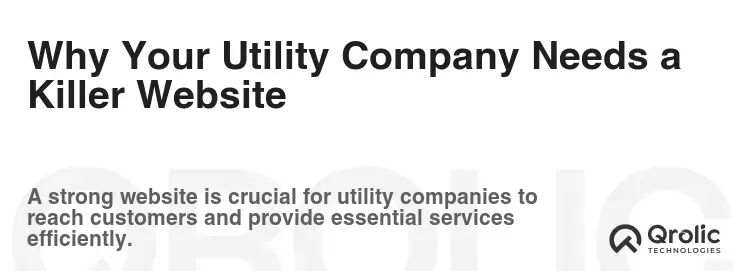
In today’s digital age, a robust online presence is no longer optional for utility companies; it’s essential. Think of your website as your digital storefront, the first point of contact for many customers, and a critical tool for managing everything from service requests to emergency communications. It’s the place where convenience meets necessity. But what makes a “killer” utility company website? It’s more than just a pretty design; it’s about functionality, accessibility, and building trust.
The Power of First Impressions: Your Digital Front Door
- Attracting New Customers: Potential customers often start their search for utility providers online. A professional, user-friendly website instantly creates a positive first impression, showcasing your reliability and competence.
- Building Trust and Credibility: A well-maintained website with clear information about your services, rates, and company history fosters trust with both current and prospective customers.
- Staying Ahead of the Competition: In a competitive market, a strong online presence can be a major differentiator. A modern, feature-rich website can set you apart and attract customers who value convenience and efficiency.
Beyond the Basics: Meeting Customer Needs Online
- 24/7 Accessibility: Customers can access information and services anytime, anywhere, without having to wait on hold or visit a physical office.
- Self-Service Options: Online bill payment, usage monitoring, service requests, and outage reporting empower customers and reduce the workload on your customer service team.
- Improved Communication: Quickly disseminate important information, such as planned outages, emergency alerts, and energy-saving tips, through website announcements and email newsletters.
- Data-Driven Insights: Track website traffic and user behavior to understand customer needs and preferences, allowing you to optimize your services and marketing efforts.
Driving Efficiency and Reducing Costs
- Reduced Call Volume: By providing comprehensive information and self-service options online, you can significantly reduce the number of calls to your customer service center.
- Streamlined Processes: Online forms and applications streamline processes for new service connections, meter readings, and other common tasks.
- Lower Marketing Costs: A well-optimized website can attract organic traffic from search engines, reducing your reliance on expensive advertising campaigns.
- Paperless Billing: Encourage customers to switch to paperless billing, reducing printing and mailing costs while promoting sustainability.
Essential Features of a High-Performing Utility Company Website

A successful utility company website is more than just a collection of pages; it’s a carefully crafted platform designed to meet the needs of your customers and streamline your operations. Here’s a breakdown of the essential features you should include:
User-Friendly Navigation and Information Architecture
- Intuitive Navigation: Ensure your website is easy to navigate, with a clear and logical menu structure that allows users to quickly find the information they need. Use clear and concise labels for menu items and avoid technical jargon.
- Search Functionality: Implement a powerful search function that allows users to easily search for specific information on your website. Make sure the search function is accurate and provides relevant results.
- Mobile-Friendly Design: With the majority of internet users accessing websites on mobile devices, it’s crucial to have a responsive website that adapts to different screen sizes and resolutions.
- Accessibility: Adhere to accessibility guidelines (WCAG) to ensure your website is usable by people with disabilities. This includes providing alternative text for images, using proper color contrast, and ensuring keyboard navigation.
Online Account Management and Self-Service
- Secure Login Portal: Provide a secure login portal for customers to access their account information, pay bills, manage their profile, and track their usage.
- Bill Payment Options: Offer a variety of online bill payment options, including credit cards, debit cards, and electronic checks. Integrate with secure payment gateways to protect customer financial information.
- Usage Monitoring Tools: Allow customers to track their energy or water usage over time, helping them identify opportunities to conserve and save money. Visualize data with easy-to-understand charts and graphs.
- Service Request Forms: Provide online forms for customers to submit service requests, such as reporting outages, requesting meter readings, or scheduling appointments.
- Paperless Billing Enrollment: Make it easy for customers to enroll in paperless billing, reducing printing and mailing costs while promoting sustainability.
Outage Reporting and Communication
- Real-Time Outage Map: Display a real-time outage map that shows the location and extent of current outages in your service area. Update the map frequently with information on estimated restoration times.
- Outage Reporting Form: Provide an easy-to-use online form for customers to report outages, including the location of the outage, the type of problem, and any other relevant information.
- Proactive Notifications: Implement a system for sending proactive notifications to customers about planned outages, emergency alerts, and other important information. Use email, SMS, and social media to reach the widest possible audience.
- Outage FAQs: Create a comprehensive FAQ section that answers common questions about outages, such as what to do during an outage, how to report an outage, and how to stay informed about restoration efforts.
Rates, Tariffs, and Regulatory Information
- Clear and Transparent Rate Schedules: Publish your current rate schedules and tariffs in a clear and easy-to-understand format. Explain how rates are calculated and what factors influence them.
- Regulatory Filings and Reports: Provide access to regulatory filings, reports, and other documents that are required by law. This demonstrates transparency and accountability to your customers and stakeholders.
- Energy Efficiency Programs and Rebates: Promote energy efficiency programs and rebates that are available to your customers. This helps them save money and reduce their environmental impact.
- Net Metering Information: If you offer net metering programs for customers with solar panels or other renewable energy sources, provide clear information on how these programs work and how to enroll.
Contact Information and Customer Support
- Prominent Contact Information: Display your contact information prominently on your website, including your phone number, email address, and physical address. Make it easy for customers to get in touch with you.
- FAQ Section: Create a comprehensive FAQ section that answers common questions about your services, rates, and policies. This can help reduce the number of calls and emails to your customer service center.
- Live Chat Support: Consider offering live chat support on your website to provide instant assistance to customers who have questions or need help.
- Online Help Center: Develop an online help center with articles, tutorials, and videos that provide guidance on common tasks, such as paying bills, reporting outages, and managing accounts.
News, Announcements, and Community Engagement
- News and Announcements Section: Use a news and announcements section to share important updates, such as planned outages, rate changes, and new programs or services.
- Blog: Create a blog where you can share informative articles, energy-saving tips, and other content that is relevant to your customers.
- Social Media Integration: Integrate your website with your social media accounts to make it easy for customers to connect with you online.
- Community Involvement: Highlight your company’s involvement in the community through sponsorships, volunteer programs, and other initiatives.
The Website Creation Process: A Step-by-Step Guide
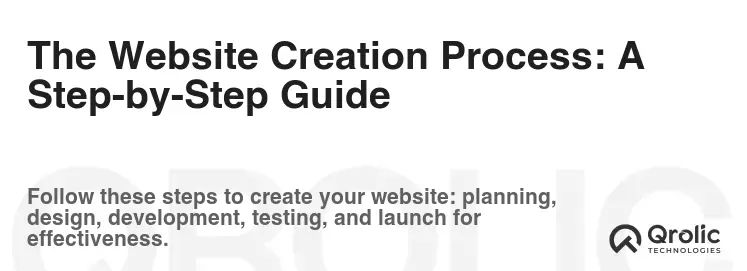
Creating a utility company website is a complex project that requires careful planning and execution. Here’s a step-by-step guide to help you navigate the process:
Step 1: Planning and Defining Your Goals
- Identify Your Target Audience: Who are your primary website users? What are their needs and expectations? Consider different customer segments, such as residential, commercial, and industrial customers.
- Define Your Website Goals: What do you want your website to achieve? Common goals include improving customer satisfaction, reducing call volume, streamlining processes, and promoting energy efficiency.
- Conduct Competitive Analysis: Analyze the websites of your competitors to identify best practices and areas where you can differentiate your website.
- Develop a Sitemap: Create a sitemap that outlines the structure and content of your website. This will help you organize your content and ensure that users can easily find what they need.
- Establish a Budget: Determine how much you are willing to spend on your website, including design, development, content creation, and ongoing maintenance.
Step 2: Design and Development
- Choose a Domain Name: Select a domain name that is easy to remember and reflects your company’s brand.
- Select a Hosting Provider: Choose a reliable hosting provider that can handle the traffic and storage needs of your website.
- Choose a Website Platform: Select a website platform that is easy to use, secure, and scalable. Popular options include WordPress, Drupal, and Joomla. Alternatively, consider a headless CMS for more flexibility with front-end technologies.
- Design Your Website: Work with a professional web designer to create a visually appealing and user-friendly website design. Ensure the design is responsive and accessible.
- Develop Your Website: Hire a web developer to build your website based on the design specifications. Ensure the developer follows best practices for security, performance, and SEO.
Step 3: Content Creation
- Develop a Content Strategy: Plan the content that you will include on your website, including text, images, videos, and other multimedia.
- Write Compelling Content: Write clear, concise, and engaging content that is relevant to your target audience. Optimize your content for search engines by using relevant keywords.
- Create High-Quality Visuals: Use high-quality images and videos to enhance your website’s visual appeal and engage your users.
- Ensure Content Accuracy: Double-check all content for accuracy and completeness. Update your content regularly to keep it fresh and relevant.
Step 4: Testing and Launch
- Thoroughly Test Your Website: Before launching your website, thoroughly test it to ensure that all features are working correctly and that there are no errors.
- Test on Different Devices and Browsers: Test your website on different devices and browsers to ensure that it is responsive and accessible.
- Conduct User Testing: Ask a group of users to test your website and provide feedback on its usability and functionality.
- Launch Your Website: Once you are satisfied that your website is ready, launch it to the public.
- Monitor Website Performance: After launching your website, monitor its performance to identify any issues and make improvements.
Step 5: Maintenance and Optimization
- Regularly Update Your Website: Keep your website up-to-date with the latest security patches and software updates.
- Monitor Website Analytics: Track website traffic and user behavior to understand how people are using your website.
- Optimize for Search Engines: Continuously optimize your website for search engines to improve its visibility in search results.
- Gather Customer Feedback: Regularly solicit feedback from your customers to identify areas where you can improve your website.
- Adapt to Changing Technologies: Stay up-to-date with the latest web technologies and adapt your website accordingly.
Choosing the Right Technology Stack
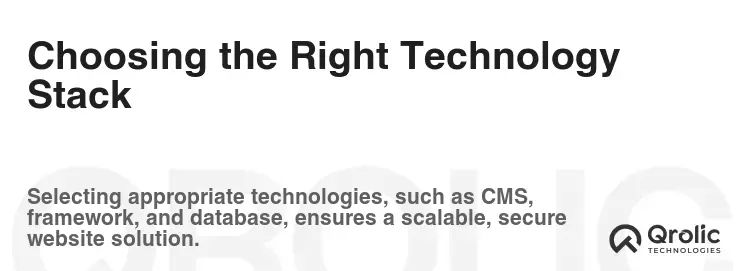
The technology stack you choose for your utility company website is a critical decision that will impact its performance, scalability, and maintainability. Here’s a breakdown of the key considerations:
Content Management System (CMS)
- WordPress: A popular and versatile CMS that is easy to use and offers a wide range of plugins and themes. Suitable for small to medium-sized utility companies with basic website needs.
- Drupal: A powerful and flexible CMS that is well-suited for complex websites with custom functionality. Ideal for larger utility companies with advanced requirements.
- Joomla: Another popular CMS that offers a good balance of ease of use and flexibility. A good option for utility companies that need a website that is both functional and visually appealing.
- Headless CMS (Contentful, Strapi, Sanity): A modern approach separating the content repository (backend) from the presentation layer (frontend). Allows for greater flexibility in technology choices for the user interface, enabling custom solutions with frameworks like React, Angular, or Vue.js. This is ideal for highly customized user experiences and integration with various data sources.
Frontend Frameworks
- React: A JavaScript library for building user interfaces. Known for its component-based architecture and performance. A popular choice for building single-page applications (SPAs) and interactive user interfaces.
- Angular: A comprehensive JavaScript framework for building complex web applications. Offers a structured approach to development and is well-suited for large-scale projects.
- Vue.js: A progressive JavaScript framework that is easy to learn and use. A good option for building small to medium-sized web applications.
Backend Technologies
- Node.js: A JavaScript runtime environment that allows you to run JavaScript on the server. Known for its speed and scalability.
- Python (Django, Flask): A versatile programming language that is widely used for web development. Django is a high-level framework that provides a lot of built-in functionality, while Flask is a lightweight framework that gives you more control.
- PHP (Laravel, Symfony): A popular server-side scripting language that is widely used for web development. Laravel is a modern PHP framework that is known for its elegant syntax and developer-friendly features.
Database
- MySQL: A popular open-source relational database management system. A good option for small to medium-sized utility companies.
- PostgreSQL: Another popular open-source relational database management system. Known for its reliability and features.
- MongoDB: A NoSQL database that is well-suited for handling unstructured data. A good option for utility companies that need to store large amounts of data from smart meters or other sensors.
Security Considerations
Security is paramount when choosing your technology stack. Ensure that the technologies you choose are regularly updated with security patches and that you implement appropriate security measures to protect customer data. Consider technologies with built-in security features and follow industry best practices for secure coding and data handling.
SEO for Utility Company Websites: Reaching Your Audience
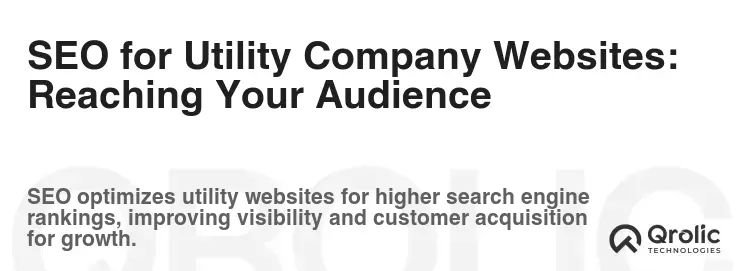
Search Engine Optimization (SEO) is crucial for ensuring that your utility company website is visible to potential customers searching for your services online. Here’s a comprehensive guide to optimizing your website for search engines:
Keyword Research
- Identify Relevant Keywords: Use keyword research tools to identify the keywords that your target audience is using to search for utility services. Consider keywords related to your service area, types of services offered, and specific customer needs. Examples include: “energy web design,” “utility website creation,” “[city/region] electricity provider,” “affordable energy plans,” “report power outage,” “water bill payment online.”
- Long-Tail Keywords: Target long-tail keywords, which are longer and more specific phrases that people use when searching for information online. Long-tail keywords can attract highly qualified traffic to your website. Example: “how to lower my electricity bill in [city],” “sign up for new electricity service [city],” “report a gas leak emergency number.”
- Analyze Competitor Keywords: Analyze the keywords that your competitors are targeting to identify opportunities to improve your own SEO strategy.
On-Page Optimization
- Title Tags: Optimize your title tags by including relevant keywords and making them compelling to click on. Title tags should be concise and accurately reflect the content of the page.
- Meta Descriptions: Write compelling meta descriptions that summarize the content of the page and encourage users to click through from the search results. Include relevant keywords in your meta descriptions.
- Header Tags (H1-H6): Use header tags to structure your content and make it easier for search engines to understand the hierarchy of information on your page. Use relevant keywords in your header tags.
- Content Optimization: Write high-quality, informative, and engaging content that is relevant to your target audience. Use relevant keywords throughout your content, but avoid keyword stuffing.
- Image Optimization: Optimize your images by using descriptive file names and alt text. This helps search engines understand what your images are about and can improve your website’s ranking in image search results.
Off-Page Optimization
- Link Building: Build high-quality backlinks from reputable websites in your industry. Backlinks are a signal to search engines that your website is authoritative and trustworthy.
- Social Media Marketing: Promote your website and content on social media to increase brand awareness and drive traffic to your website.
- Local SEO: Optimize your website for local search by claiming your business listing on Google My Business and other local directories. This will help you attract customers who are searching for utility services in your area.
- Online Reviews: Encourage customers to leave online reviews on Google, Yelp, and other review sites. Positive reviews can improve your website’s ranking in search results and build trust with potential customers.
Technical SEO
- Website Speed: Optimize your website for speed by reducing image sizes, caching content, and using a Content Delivery Network (CDN).
- Mobile-Friendliness: Ensure that your website is mobile-friendly and responsive. Google prioritizes mobile-friendly websites in its search results.
- XML Sitemap: Create an XML sitemap and submit it to Google Search Console. This helps search engines crawl and index your website more efficiently.
- Robots.txt File: Use a robots.txt file to prevent search engines from crawling and indexing certain pages on your website.
- SSL Certificate: Install an SSL certificate to secure your website and protect customer data. Google prioritizes secure websites in its search results.
Monitoring and Analysis
- Track Website Traffic: Use Google Analytics to track website traffic and user behavior. This will help you understand how people are using your website and identify areas where you can make improvements.
- Monitor Keyword Rankings: Track your keyword rankings in search results to see how your SEO efforts are paying off.
- Analyze Backlink Profile: Regularly analyze your backlink profile to identify any toxic or low-quality backlinks that could be hurting your SEO.
Utility Website Design Best Practices: User Experience is King
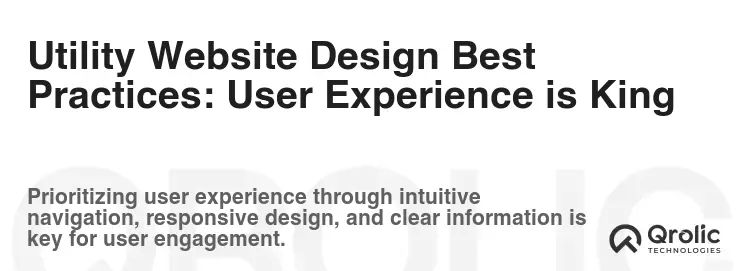
Creating a visually appealing website is just one piece of the puzzle. A truly successful utility website prioritizes user experience (UX) above all else. Here’s how to create a website that your customers will love to use:
Clear and Concise Information
- Avoid Jargon: Use plain language and avoid technical jargon that your customers may not understand.
- Prioritize Key Information: Make it easy for customers to find the information they need, such as rates, outage reporting, and contact information.
- Use Visuals: Use images, videos, and infographics to break up text and make your website more engaging.
Intuitive Navigation
- Simple Menu Structure: Create a clear and logical menu structure that allows users to easily find what they are looking for.
- Search Functionality: Implement a robust search function that allows users to quickly search for specific information on your website.
- Breadcrumb Navigation: Use breadcrumb navigation to help users understand their location on your website and easily navigate back to previous pages.
Mobile-First Design
- Responsive Design: Ensure that your website is responsive and adapts to different screen sizes and resolutions.
- Touch-Friendly Navigation: Design your website with touch-friendly navigation in mind, making it easy for users to interact with your website on mobile devices.
- Optimize for Speed: Optimize your website for speed on mobile devices by reducing image sizes, caching content, and using a CDN.
Accessibility
- WCAG Compliance: Adhere to the Web Content Accessibility Guidelines (WCAG) to ensure that your website is usable by people with disabilities.
- Alternative Text for Images: Provide alternative text for images so that users with screen readers can understand what the images are about.
- Keyboard Navigation: Ensure that your website can be navigated using a keyboard alone.
- Color Contrast: Use sufficient color contrast to ensure that text is readable by people with visual impairments.
Call to Actions
- Clear and Concise CTAs: Use clear and concise calls to action (CTAs) to encourage users to take specific actions on your website, such as paying bills, reporting outages, or signing up for email updates.
- Prominent Placement: Place your CTAs prominently on your website so that they are easy to see and click on.
- Use Action Words: Use action words in your CTAs, such as “Pay Now,” “Report Outage,” and “Sign Up.”
Testing and Iteration
- User Testing: Conduct user testing to get feedback on your website’s usability and functionality.
- A/B Testing: Use A/B testing to compare different versions of your website and see which performs better.
- Continuous Improvement: Continuously monitor your website’s performance and make improvements based on user feedback and data analysis.
Content Strategy for Utility Companies: Engaging Your Customers
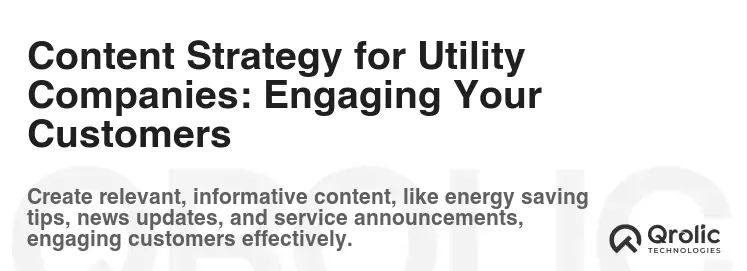
Your website’s content is what truly connects you with your customers. A well-defined content strategy can build trust, educate, and drive engagement. Here’s how to develop a winning content strategy:
Understanding Your Audience
- Customer Personas: Create detailed customer personas that represent your different customer segments. This will help you understand their needs, preferences, and pain points.
- Content Mapping: Map out the content that you need to create to address the needs of each customer persona at different stages of the customer journey.
- Voice and Tone: Define the voice and tone that you will use in your content. Your voice should be consistent with your brand and should resonate with your target audience.
Content Types
- Blog Posts: Share informative and engaging blog posts on topics that are relevant to your customers, such as energy-saving tips, outage preparedness, and renewable energy.
- Articles: Publish in-depth articles on complex topics, such as rate structures, regulatory policies, and technology advancements.
- Videos: Create engaging videos that explain complex concepts, showcase your company’s values, or provide customer testimonials.
- Infographics: Use infographics to visualize data and present information in an easy-to-understand format.
- Case Studies: Share case studies that highlight how your company has helped customers save money or improve their energy efficiency.
- FAQ Section: Create a comprehensive FAQ section that answers common questions about your services, rates, and policies.
Content Calendar
- Plan Your Content: Create a content calendar that outlines the topics you will cover, the content types you will use, and the publication dates.
- Repurpose Content: Repurpose existing content into different formats to reach a wider audience. For example, you can turn a blog post into a video or an infographic.
- Promote Your Content: Promote your content on social media, email, and other channels to drive traffic to your website.
Measuring Success
- Track Website Traffic: Use Google Analytics to track website traffic and user behavior.
- Monitor Engagement: Monitor social media engagement, email open rates, and other metrics to measure the success of your content.
- Gather Feedback: Solicit feedback from your customers to identify areas where you can improve your content.
Integrating with Existing Systems: Streamlining Operations
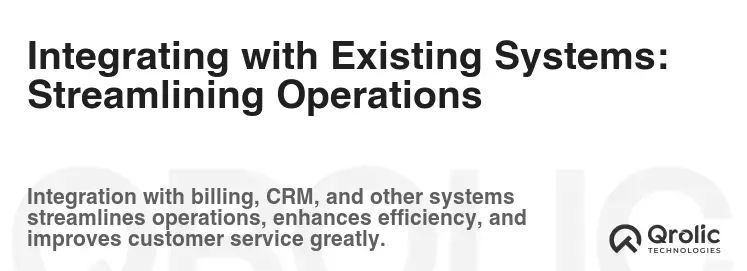
Your website should seamlessly integrate with your existing systems to streamline operations and improve efficiency. Here’s how to integrate your website with your Customer Information System (CIS), Geographic Information System (GIS), and other key systems:
Customer Information System (CIS) Integration
- Account Management: Allow customers to access their account information, pay bills, and manage their profiles directly from your website.
- Service Requests: Integrate your website with your CIS to allow customers to submit service requests online.
- Outage Reporting: Integrate your website with your CIS to allow customers to report outages online.
- Real-Time Data: Display real-time data from your CIS on your website, such as outage maps and usage information.
Geographic Information System (GIS) Integration
- Outage Mapping: Display a real-time outage map on your website that shows the location and extent of current outages.
- Service Area Mapping: Display a map of your service area on your website.
- Asset Management: Integrate your website with your GIS to allow customers to view information about your assets, such as power lines and water pipes.
Other System Integrations
- Payment Gateways: Integrate your website with secure payment gateways to allow customers to pay their bills online.
- Email Marketing Platforms: Integrate your website with email marketing platforms to send automated email updates to your customers.
- Social Media Platforms: Integrate your website with social media platforms to share content and engage with your customers online.
API Integrations
- Utilize APIs: Use APIs (Application Programming Interfaces) to connect your website with your existing systems. APIs allow you to exchange data between different systems in a secure and efficient manner.
- Security Considerations: Ensure that your API integrations are secure and protect customer data.
Budgeting for Your Utility Company Website: Investing in the Future

Creating a high-quality utility company website is an investment that can pay off in the long run. Here’s how to budget for your website:
Website Design and Development Costs
- Design Costs: Factor in the cost of website design, including wireframing, mockups, and graphic design.
- Development Costs: Factor in the cost of website development, including coding, testing, and deployment.
- CMS Costs: Factor in the cost of a Content Management System (CMS), such as WordPress, Drupal, or Joomla.
- Hosting Costs: Factor in the cost of website hosting, including server space, bandwidth, and security.
Content Creation Costs
- Content Writing Costs: Factor in the cost of content writing, including blog posts, articles, and website copy.
- Graphic Design Costs: Factor in the cost of graphic design, including images, videos, and infographics.
- Video Production Costs: Factor in the cost of video production, including filming, editing, and post-production.
Ongoing Maintenance Costs
- Security Updates: Factor in the cost of security updates and maintenance to protect your website from hackers and malware.
- Content Updates: Factor in the cost of content updates to keep your website fresh and relevant.
- Technical Support: Factor in the cost of technical support to address any issues that may arise.
Marketing and Promotion Costs
- SEO Costs: Factor in the cost of Search Engine Optimization (SEO) to improve your website’s visibility in search results.
- Social Media Marketing Costs: Factor in the cost of social media marketing to promote your website and engage with your customers online.
- Paid Advertising Costs: Factor in the cost of paid advertising, such as Google Ads and social media ads, to drive traffic to your website.
Cost-Saving Strategies
- Use Open-Source Software: Use open-source software, such as WordPress and Drupal, to reduce your website development costs.
- Outsource Content Creation: Outsource content creation to freelance writers and designers to save money.
- DIY Website Maintenance: Learn how to perform basic website maintenance tasks yourself to reduce your ongoing maintenance costs.
Qrolic Technologies: Your Partner in Digital Transformation

At Qrolic Technologies (https://qrolic.com/), we understand the unique challenges and opportunities that utility companies face in today’s digital landscape. We are a leading provider of custom software development and digital transformation services, and we are passionate about helping utility companies like yours leverage technology to improve customer engagement, streamline operations, and drive innovation.
Our Expertise
- Utility Industry Expertise: We have extensive experience working with utility companies of all sizes, and we understand the specific needs and challenges of the industry.
- Custom Software Development: We specialize in developing custom software solutions that are tailored to your unique business requirements.
- Website Development: We create visually appealing, user-friendly, and SEO-optimized websites that help you attract and retain customers.
- Mobile App Development: We develop mobile apps that allow your customers to access your services on the go.
- Cloud Computing: We help you migrate your IT infrastructure to the cloud to improve scalability, reliability, and cost-effectiveness.
- Data Analytics: We help you collect, analyze, and interpret data to gain valuable insights into your business.
- Cybersecurity: We provide comprehensive cybersecurity services to protect your IT infrastructure from threats.
Our Services
- Website Design and Development: We create visually appealing and user-friendly websites that are optimized for search engines and mobile devices.
- Mobile App Development: We develop custom mobile apps for iOS and Android devices that allow your customers to access your services on the go.
- Custom Software Development: We develop custom software solutions that are tailored to your unique business requirements.
- Cloud Migration: We help you migrate your IT infrastructure to the cloud to improve scalability, reliability, and cost-effectiveness.
- Data Analytics: We help you collect, analyze, and interpret data to gain valuable insights into your business.
- Cybersecurity: We provide comprehensive cybersecurity services to protect your IT infrastructure from threats.
- IT Consulting: We provide IT consulting services to help you develop a technology strategy that aligns with your business goals.
Why Choose Qrolic Technologies?
- Experience: We have a proven track record of success working with utility companies.
- Expertise: Our team of experts has the skills and knowledge to deliver high-quality solutions that meet your needs.
- Customer Focus: We are committed to providing excellent customer service and building long-term relationships with our clients.
- Innovation: We are constantly exploring new technologies and approaches to help our clients stay ahead of the curve.
- Affordability: We offer competitive pricing and flexible payment options to fit your budget.
Partner with Qrolic Technologies to transform your digital presence and unlock new opportunities for growth and efficiency. Visit our website at https://qrolic.com/ to learn more about our services and how we can help your utility company succeed in the digital age.






